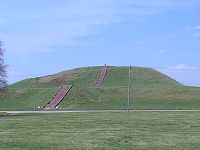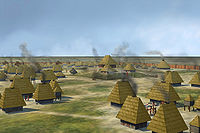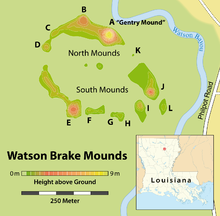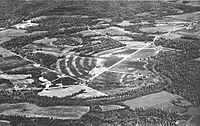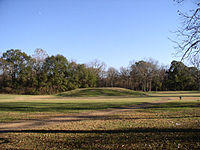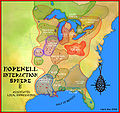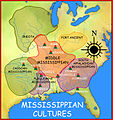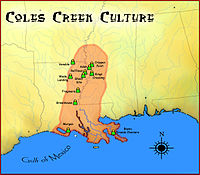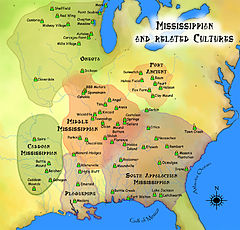- Mound builder (people)
-
For other uses, see Mound builder (disambiguation).Monks Mound, located at the Cahokia Mounds UNESCO World Heritage Site near Collinsville, Illinois, is the largest Pre-Columbian earthwork in America north of Mesoamerica.

 Grave Creek Mound, located in Moundsville, West Virginia, is one of the largest conical mounds in the United States. It was built by the Adena culture.
Grave Creek Mound, located in Moundsville, West Virginia, is one of the largest conical mounds in the United States. It was built by the Adena culture.
The group of cultures collectively called Mound Builders were prehistoric inhabitants of North America who constructed various styles of earthen mounds for religious and ceremonial, burial, and elite residential purposes. These included the Pre-Columbian cultures of the Archaic period; Woodland period (Adena and Hopewell cultures); and Mississippian period; dating from roughly 3400 BCE to the 16th century CE, and living in regions of the Great Lakes, the Ohio River valley, and the Mississippi River valley and its tributaries.[1] As a comparison, beginning with the construction of Watson Brake about 3400 BCE in present-day Louisiana, indigenous peoples started building earthwork mounds in North America nearly 1000 years before the pyramids were constructed in Egypt.
Since the 19th century, the prevailing scholarly consensus has been that the mounds were constructed by Indigenous peoples of the Americas, early cultures distinctly separate from the historical Native American tribes extant at the time of European colonization of North America. The historical Native Americans were generally not knowledgeable about the civilizations that produced the mounds. Research and study of these cultures and peoples has been based on archaeology and anthropology.
Contents
Name and culture
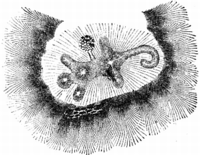 Alligator Effigy Mound, Ohio
Alligator Effigy Mound, Ohio
At one time, the term "mound builder" was applied to the imaginary race believed to have constructed these earthworks. In the 16th-19th centuries, Europeans and Americans generally thought that a race other than one related to the historic Native Americans had built the mounds.
The namesake cultural trait of the mound builders was the building of mounds and other earthworks. These burial and ceremonial structures were typically flat-topped pyramids or platform mounds, flat-topped or rounded cones, elongated ridges, and sometimes a variety of other forms. They were built as part of complex villages that attracted more dense populations, with a specialization of skills and knowledge. The best-known flat-topped pyramidal structure, which at over 100 feet (30 m) tall is the largest pre-Columbian earthwork north of Mexico, is Monks Mound at Cahokia Indian Mounds in present-day Collinsville, Illinois. Cahokia was an urban settlement with 20,000-30,000 people at its peak about 1150 CE, a population that was not exceeded in North American European settlements until after 1800.
Some effigy mounds were constructed in the shapes or outlines of culturally significant animals. The most famous effigy mound, Serpent Mound in southern Ohio, is 5 feet (1.5 m) tall, 20 feet (6 m) wide, over 1,330 feet (405 m) long, and shaped as an undulating serpent.
Many different tribal groups and chiefdoms, involving an array of beliefs and unique cultures over thousands of years, built mounds as expressions of their cultures. The general term, "mound builder," covered their shared architectural practice of earthwork mound construction. This practice, believed to be associated with a cosmology that had a cross-cultural appeal, may indicate common cultural antecedents. The first mound building was an early marker of political and social complexity among the cultures in the Eastern United States. Watson Brake in Louisiana, constructed about 3500 BCE during the Middle Archaic period, is the oldest dated mound complex in North America and the present-day United States. It is one of eleven mound complexes from this period found in the Lower Mississippi Valley.[2]
Archaeological surveys
The most complete reference for these earthworks is Ancient Monuments of the Mississippi Valley, written by Ephraim G. Squier and Edwin H. Davis. It was published in 1848 by the Smithsonian Institution. Since many of the features which the authors documented have since been destroyed or diminished by farming and development, their surveys, sketches, and descriptions are still used by modern archaeologists. All of the sites which they identified as located in Kentucky came from the manuscripts of C. S. Rafinesque.
A smaller regional study in 1931 by author and archaeologist Fred Dustin charted and examined the mounds and Ogemaw Earthworks near Saginaw, Michigan. Archaeological survey and recording of mounds is an ongoing scholarly task.
Reports of early European explorers
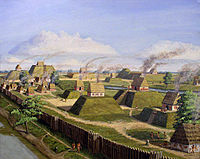 The Kincaid Site, a Mississippian settlement in southern Illinois
The Kincaid Site, a Mississippian settlement in southern Illinois
Hernando de Soto, the Spanish conquistador who in 1540-42 traversed what became the southeast United States, encountered many different mound-builder peoples, perhaps descendants of the great Mississippian culture. The mound-building tradition was still alive in the southeast during the mid-sixteenth century. De Soto observed people living in fortified towns with lofty mounds and plazas, and surmised that many of the mounds served as foundations for priestly temples. Near present-day Augusta, Georgia, de Soto encountered a mound-building group ruled over by a queen, Cofitachequi. She told him that the mounds within her territory served as the burial places for nobles.
The artist Jacques Le Moyne, who had accompanied French settlers to northeastern Florida in the 1560s, likewise noted many Native American groups using existing mounds and constructing others. He produced a series of watercolor paintings depicting scenes of native life. Although most of his paintings have been lost, some engravings were copied from the originals and published in 1591 by a Flemish company. Among these is a depiction of the burial of an aboriginal Floridian tribal chief, an occasion of great mourning and ceremony. The original caption reads:
“ Sometimes the deceased king of this province is buried with great solemnity, and his great cup from which he was accustomed to drink is placed on a tumulus with many arrows set about it. ” —- Jacques Le Moyne 1650's
Maturin Le Petit, a Jesuit priest (1619), and Le Page du Pratz (1758), a French explorer, both observed the Natchez in what was later Mississippi. The Natchez were devout worshippers of the sun. Having a population of some 4,000, they occupied at least nine villages and were presided over by a paramount chief, known as the Great Sun, who wielded absolute power. Both observers noted the high temple mounds which the Natchez had built so that the Great Sun could commune with God, the sun. His large residence was built atop the highest mound, from
“ " which, every morning, he greeted the rising sun, invoking thanks and blowing tobacco smoke to the four cardinal directions." ” —- Le Page du Pratz 1758
Later explorers to the same regions, only a few decades after mound-building settlements had been reported, found the regions largely depopulated, the residents vanished, and the mounds untended. Since there had been little violent conflict with Europeans during that period, the most plausible explanation is that new Eurasian infectious diseases, such as smallpox and influenza, had decimated most of the Native Americans who had comprised the last mound-builder civilization.[6][7][8][9]
Mound building cultures
Archaic era
Radiocarbon dating has established the age of the earliest Archaic mound complex in southeastern Louisiana. One of the two Monte Sano Site mounds, excavated in 1967 before being destroyed during new construction at Baton Rouge, was dated at 6220 BP (plus or minus 140 years).[10] Researchers at the time thought that such societies were not organizationally capable of this type construction.[10] It has since been dated as about 6500 BP, or 4500 BCE,[11] although not all agree.[12]
Watson Brake is located in the floodplain of the Ouachita River near Monroe in northern Louisiana. Securely dated to about 5400 years ago (approx. 3500 BCE), in the Middle Archaic period, it consists of a formation of 11 mounds from three to 25 feet (1-8m) tall, connected by ridges to form an oval nearly 900 feet (270m) across.[13] In the Americas, building of complex earthwork mounds started at an early date, well before the pyramids of Egypt were constructed. Watson Brake was under construction nearly 2,000 years before the better-known Poverty Point, and building went on for 500 years.[14] Middle Archaic mound construction appeared to cease about 2800 BC, and scholars have not ascertained the reason, but it may have been because of changed in river patterns or other environmental factors.[15]
With the 1990s dating of Watson Brake and similar complexes, scholars established that pre-agricultural, pre-ceramic American societies could organize to accomplish complex construction over extended periods of time, overturning scholars' understanding of traditional models of Archaic society.[16] Watson Brake was built by a hunter-gatherer society whose people occupied the area on only a seasonal basis, but where successive generations organized to build the complex mounds over a 500-year period. Their food consisted mostly of fish and deer, as well as available plants.
Built about 1500 BC, Poverty Point in Louisiana is a prominent example of Late Archaic mound-builder construction (c. 2500 BCE - 1000 BCE). It is a striking complex of more than one square mile, where six earthwork crescent ridges were built in concentric arrangement, interrupted by radial aisles. Three mounds are also part of the main complex, and evidence of residences extends for about three miles along the bank of Bayou Maçon. It is the major site among 100 associated with the Poverty Point culture, and is one of the best-known early examples of earthwork monumental architecture. Unlike the localized societies during the Middle Archaic, this culture showed evidence of a wide trading network outside its area, which is one of its distinguishing characteristics.
Woodland period
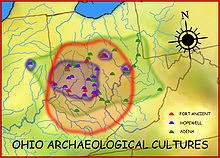 Adena culture map
Adena culture map
The Archaic period was followed by the Woodland period (c. 1000 BCE). Some well-understood examples are the Adena culture of Ohio and nearby states. The subsequent Hopewell culture built monuments from Illinois to Ohio and was renowned for its geometric earthworks. The Adena and Hopewell were not the only mound-building peoples during this time period. There were contemporaneous mound-building cultures throughout the Eastern United States. During this time period, the Hopewellian Marksville culture declined and gave way to the Baytown culture in parts of Mississippi, Arkansas, and Louisiana.[17]
Coles Creek culture
The Coles Creek culture is a Late Woodland culture (700-1200 CE) in the Lower Mississippi Valley in the southern United States that marks a significant change in the cultural history of the area. Population and cultural and political complexity increased, especially by the end of the Coles Creek period. Although many of the classic traits of chiefdom societies are not yet manifested, by 1000 CE the formation of simple elite polities had begun. Coles Creek sites are found in Arkansas, Louisiana, Oklahoma, Mississippi and Texas. The Coles Creek culture is considered ancestral to the Plaquemine culture.[18][19]
Mississippian culture
Around 900–1450 CE, the Mississippian culture developed and spread through the Eastern United States, primarily along the river valleys.[20] The largest regional center where the Mississippian culture is first clearly developed is located in Illinois, and is referred to today as Cahokia. It had several regional variants including the Middle Mississippian culture of Cahokia, the South Appalachian Mississippian variant at Moundville and Etowah, the Plaquemine Mississippian variant in south Louisiana and Mississippi,[21] and the Caddoan Mississippian culture of northwestern Louisiana, eastern Texas, and southwestern Arkansas.[22]
Fort Ancient
Fort Ancient is the name for a Native American culture that flourished from 1000-1650 C.E. among a people who predominantly inhabited land along the Ohio River in areas of southern modern-day Ohio, northern Kentucky and western West Virginia. Scholars once thought this was an expansion of the Mississippian cultures, but they now believe the Fort Ancient culture was an independently developed culture descended from the Hopewell culture.
Plaquemine culture
This was an archaeological culture in the lower Mississippi River Valley in western Mississippi and eastern Louisiana. Good examples of this culture are the Medora Site in West Baton Rouge Parish, La; and the Anna, Emerald Mound, Winterville and Holly Bluff (Lake George) sites in Mississippi.[23] Plaquemine culture was contemporaneous with the Middle Mississippian culture at the Cahokia site in Illinois. It is considered ancestral to the Natchez and Taensa peoples.[24]
Alternative explanations
Through the mid-nineteenth century, European Americans did not recognize that ancestors of the Native Americans built the mounds of the eastern U.S. They believed that the complex earthworks and large ceremonial complexes were built by a different people. The antiquarian author William Pidgeon epitomized this view; Pidgeon supported his conclusions by creating fraudulent surveys of mound groups that did not exist.[25][26][27]
A key work in increasing public knowledge of the origins of the mounds was the 1894 report by Cyrus Thomas of the Bureau of American Ethnology. He concluded that the prehistoric earthworks of the eastern United States were the work of Native Americans. A small number of people had earlier reached similar conclusions: Thomas Jefferson, for example, excavated a mound and from the artifacts and burial practices, noted similarities between mound-builder funeral practices and those of Native Americans in his time, and Theodore H. Lewis had refuted Pidgeon's fradulent claims of pre-Native American moundbuilders in 1886.[28]
Writers and scholars have put forward numerous alternative origins for the mound builders:
- Vikings
Benjamin Smith Barton proposed the theory that the mound builders were Vikings who came to North America and eventually disappeared.
- Ancient world immigrants
Other people believed that Greeks, Africans, Chinese or assorted Europeans built the mounds. Euro-americans who embraced a Biblical worldview sometimes thought the Ten Lost Tribes of Israel had built the mounds.
- Book of Mormon inhabitants
See also: Archaeology and the Book of MormonDuring the 1800s, a common folklore was that Jews -- particularly the Lost Ten Tribes -- were the ancestors of Native Americans and the mound builders. The Book of Mormon (first published in 1830) provides an example of this belief, as its narrative describes two waves of immigration to the Americas from Mesopotamia: the Jaredites (ca. 3000 - 2000 BCE) and an Israelite group in 590 BCE (called Nephites, Lamanites and Mulekites). The Book of Mormon depicts these settlers' building magnificent cities, only to be later destroyed by warfare around 385 CE.
Some Mormon scholars have considered The Book of Mormon narrative a description of the mound-building cultures; other Mormon apologists argue for a Mesoamerican or South American setting. Theories about a Mesoamerican setting for the Book of Mormon did not arise until after Latter-day Saints (LDS)(Mormons) were influenced by publicized findings about the Central American stone ruins. This occurred after the Book of Mormon was published.[29]
- Black civilizations
Certain sects affiliated with the 20th-century Black nationalist Moorish Science philosophy theorized a connection with the mound builders. They argue that the mound builders were an ancient advanced Black civilization that developed the legendary continents of Atlantis and Mu, as well as ancient Egypt and Mesoamerica. These black groups, similar to European Americans in earlier periods, propose that the American Indians were too uncivilized to have developed the sophisticated societies and the technology believed necessary to build the mounds.
- Divine creation
The Reverend Landon West claimed that Serpent Mound in Ohio was built by God, or by man inspired by him. He believed that God built the mound and placed it as a symbol of the story of the Garden of Eden.[30][31]
- Mythical cultures
Some people attributed the mounds to mythical cultures: Lafcadio Hearn suggested that the mounds were built by people from the Lost Continent of Atlantis.
Effects of alternative explanations
The mound builder explanations were often honest misinterpretations of real data from valid sources. Both scholars and laymen accepted some of these explanations. Reference to an alleged race appears in the poem "The Prairies" (1832) by William Cullen Bryant.[32]
- Assumption that construction was too complex for Indians
One belief was that American Indians were too simple to have constructed such complex earthworks and artifacts. The associated stone, metal, and clay artifacts were thought to be too complex for the Indians to make. However, in the American Southeast, Northeast, and Midwest, numerous Indian cultures were sedentary and participated in agriculture. Numerous Indian towns had built surrounding stockades for defense. Capable of this type of construction, they and ancestors could have built mounds. People who believed that the Indians did not build the earthworks thought their nomadic cultures meant they would not build such monuments. In this view, they could not have devoted the time and effort to construct mounds and other time-consuming projects.
When most Europeans first arrived in America, they never witnessed the American Indians building mounds; when asked about the mounds, most of the Indians did not know anything about them. Yet earlier Europeans, especially the Spanish, had written numerous accounts about the Indians' construction of mounds. As these works were not translated into English for some time, they were not accessible to Anglo-American scholars working only in English and classical languages. Inca Garcilaso de la Vega reported how the Indians built the mounds and the temples placed on top of them. A few French expeditions reported staying with Indian societies who built mounds.
- Assumption construction older than Indians
People also claimed that the Indians were not the mound builders because the mounds and related artifacts were older than Indian cultures. Caleb Atwater's misunderstanding of stratigraphy led him to believe that the mound builders were a much older civilization than the Indians. In his book, Antiquities Discovered in the Western States (1820), Atwater claimed that Indian remains were always found right beneath the surface of the earth. Since the artifacts associated with the mound builders were found fairly deep in the ground, Atwater argued that they must be from a different group of people. The discovery of metal artifacts further convinced people that the mound builders were not Native Americans. The Indians encountered by the Europeans and Americans were not known to engage in metallurgy. This was another incorrect conclusion based on the false assumption that all Indian cultures are similar. Some artifacts that were found in relation to the mounds were inscribed with symbols. As the Europeans did not know of any Indian cultures that had a writing system, they assumed a different group had created them.
Hoaxes
Several hoaxes were based on the mound builders.
- Newark Holy Stones
In 1860, David Wyrick discovered the "Keystone tablet", containing Hebrew language inscriptions written on it in Newark, Ohio. Soon after, he found the "Newark Decalogue Stone" nearby, also claimed to contain Hebrew. It was later discovered that Reverend John W. McCarty created these "Newark Holy Stones" and put them in a place where Wyrick would find them.[citation needed]
- Davenport tablets
Another hoax related to the mound builders was the discovery of the Davenport tablets by Reverend Jacob Gass. These also bore inscriptions that later were found to be fake.
- Walam Olum hoax
The Walam Olum hoax had considerable influence on perceptions of the mound builders. In 1836 Constantine Samuel Rafinesque published his translation of a text he claimed had been written in pictographs on wooden tablets. This text explained the origin of the Lenape Indians in Asia, told of their passage over the Bering Strait, and narrated their subsequent migration across the North American continent. This “Walam Olum” tells of battles with native peoples already in America before the Lenape arrived. It was assumed by others that these original people were the mound builders, and that the Lenape Indians overthrew them and destroyed their culture. David Oestreicher later branded Rafinesque's story a hoax. He argued that the Walam Olum glyphs derived from Chinese, Egyptian, and Mayan alphabets. Meanwhile, the belief that the Native Americans destroyed the mound builder culture had earned widespread acceptance.
- Kinderhook Plates
The Kinderhook plates, "discovered" in 1843, were another hoax of material planted in Native American mounds. This hoax, however, had the aim of discrediting the supposed translation powers of Mormon prophet Joseph Smith.
See also
 Panoramic view from within the Great Circle at the Newark Earthworks in Newark, Ohio (wall of which can be seen in the background)
Panoramic view from within the Great Circle at the Newark Earthworks in Newark, Ohio (wall of which can be seen in the background)
- List of burial mounds in the United States
- Petroforms
- Serpent Mound
- Southeastern Ceremonial Complex
- Tumulus, Mounds (or barrows) of Europe and Asia
Notes
- ^ See Squier p. 1
- ^ Robert W. Preucel, Stephen A. Mrozowski, Contemporary Archaeology in Theory: The New Pragmatism, John Wiley & Sons, 2010, p. 177
- ^ Mallory O'Connor, Lost Cities of the Ancient Southeast (University Press of Florida, 1995)
- ^ Ephraim Squier and Edwin Davis, Ancient Monuments of the Mississippi Valley (Smithsonian Contributions to Knowledge, vol. 1. Washington DC, 1848)
- ^ Biloine Young and Melvin Fowler, Cahokia: The Great Native American Metropolis (University of Illinois Press, 2000)
- ^ Davis Brose and N'omi Greber (eds.), Hopewell Archaeology (Kent State UP, 1979)
- ^ Roger Kennedy, Hidden Cities: The Discovery and Loss of Ancient North American Civilization (Free Press, 1994)
- ^ Robert Silverberg, "...And the Mound-Builders Vanished from the Earth", originally in the 1969 edition of American Heritage, collected in the anthology A Sense of History [Houghton-Mifflin, 1985]; available online here.
- ^ Gordon M. Sayre, "The Mound Builders and the Imagination of American Antiquity in Jefferson, Bartram, and Chateaubriand", Early American Literature 33 (1998): 225-249.
- ^ a b Rebecca Saunders, "The Case for Archaic Period Mounds in Southeastern Louisiana", Southeastern Archaeology, Vol. 13, No. 2, Winter 1994, accessed 4 November 2011
- ^ "Important new findings in Louisiana". Archaeo News. Stone Pages. http://www.stonepages.com/news/archives/000363.html. Retrieved 5 September 2011.
- ^ Joe W. Saunders, "Middle Archaic and Watson Brake", in Archaeology of Louisiana, edited by Mark A. Rees, Ian W. (FRW) Brown, LSU Press, 2010, p. 67
- ^ Saunders, in Rees and Brown (2010), Archaeology of Louisiana, pp. 69-76
- ^ Saunders, in Rees and Brown (2010), Archaeology of Louisiana, pp. 69-76
- ^ Saunders, in Rees and Brown (2010), Archaeology of Louisiana, pp. 73-74
- ^ Saunders, in Rees and Brown (2010), Archaeology of Louisiana, p. 63
- ^ "Southeastern Prehistory-Late Woodland Period". http://www.nps.gov/seac/outline/04-woodland/index-3.htm. Retrieved 2008-09-23.
- ^ Kidder, Tristram (1998). R. Barry Lewis, Charles Stout. ed. Mississippian Towns and Sacred Spaces. University of Alabama Press. ISBN 0-8173-0947-0.
- ^ "Troyville-Coles Creek". Louisiana prehistory. 2010-07-01. http://www.crt.state.la.us/archaeology/virtualbooks/LAPREHIS/marca.htm.
- ^ Adam King (2002). "Mississippian Period: Overview". New Georgia Encyclopedia. http://www.georgiaencyclopedia.org/nge/Article.jsp?id=h-707. Retrieved 2010-07-01.
- ^ "Mississippian and Late Prehistoric Period". http://www.nps.gov/seac/outline/05-mississippian/index.htm. Retrieved 2010-07-01.
- ^ Peter N. Peregrine (1995). Archaeology of the Mississippian culture: a research guide. Garland Publishing. p. 165. ISBN 978-0-8153-0336-7.
- ^ "Mississippian and Late Prehistoric Period". http://www.nps.gov/seac/outline/05-mississippian/index.htm. Retrieved 2008-09-08.
- ^ "The Plaquemine Culture, A.D 1000". http://bcn.boulder.co.us/environment/cacv/cacvbrvl.htm. Retrieved 2008-09-08.
- ^ Pidgeon, William (1858) Traditions of Dee-Coo-Dah and Antiquarian Researches. Horace Thayer, New York.
- ^ Finney, Fred (2008) William Pidgeon and T.H. Lewis. Minnesota Archaeologist 67: 89-105
- ^ Birmingham, Robert A. and Leslie E. Eisenberg (2000) Indian Mounds of Wisconsin. University of Wisconsin Press, Madison, Wisconsin, pp 24-27.
- ^ Lewis, Theodore H. (1886) "The 'Monumental Tortoise' Mounds of 'Dee-Coo-Dah'" The American Journal of Archaeology 2(1):65-69.
- ^ See the anonymous newspaper article titled "ZARAHEMLA", Mormon Times and Seasons, October 1842. excerpts from John Lloyd Stephens, Incident of Travel in Central America, Chiapas and Yucatan (1841). Stephens’ conclusion that the Central American stone ruins were not of any great antiquity was overlooked by excited LDS readers.
- ^ Ohio Historical Society. "Ohio history, Volume 10". http://books.google.com/books?pg=PA225&lpg=PA225&dq=Landon%20West%20reverend&sig=xH3okSLAZOI_7kCKV7_lyMgaiwc&ei=TDEtTs3WD-2msAKqnd2GCw&ct=result&id=SbYBG7ynKZAC&ots=zdG1YgwLtn&output=text. Retrieved 2011-07-25. "The Garden of Eden, it seems, is now definitely located. The site is in Ohio, "Adams" county, to be more precise...The Rev. Landon West of Pleasant Hill, O., a prominent and widely known minister of the Baptist church... arrives at the conclusion that this great work was created either by God himself or by man inspired by Him to make an everlasting object lesson of man's disobedience, Satan's perfidy and the results of sin and death. In support of this startling claim the Rev. Mr. West quotes Scripture and refers to Job 16:13: "By His spirit. He hath garnished the heavens; His hand hath formed the crooked serpent.""
- ^ BROOK WILENSKY-LANFORD (May 23rd, 2011). "ADAM AND EVE--AND REVEREND WEST--IN OHIO". The Common. http://www.thecommononline.org/features/adam-and-eve-and-reverend-west-ohio. "the Eden I found in a 1909 pamphlet by Reverend Landon West—the Serpent Mound earthwork that is now an Ohio state park—was still preserved for all to see, so I went...Details that fell outside of West’s lifetime were hard to fit into the book: his son Daniel became the founder of the Heifer Project charity, and his accomplishments no doubt helped preserve the memory of his father’s Garden of Eden."
- ^ Bryant, William Cullen, "The Prairies" (1832)
References
- Abrams, Elliot M.; Freter, AnnCorinne (eds.). (2005). The Emergence of the Moundbuilders: The Archaeology of Tribal Societies in Southeastern Ohio. Athens: Ohio University Press. ISBN 9780821416099.
- Thomas, Cyrus. Report on the mound explorations of the Bureau of Ethnology. Pp. 3–730. Twelfth annual report of the Bureau of Ethnology to the Secretary of the Smithsonian Institution, 1890–91, by J. W. Powell, Director. XLVIII+742 pp., 42 pls., 344 figs. 1894.
- Feder, Kenneth L.. Frauds, Myths, and Mysteries: Science and Pseudoscience in Archaeology’’. 5th ed. New York: McGraw Hill, 2006.
- Squier, A.M., E.G.; Davis M.D., E.H. (1847). Ancient Monuments of the Mississippi Valley. Washington DC: Smithsonian Institution.
Further reading
- Gale, George (1867). Upper Mississippi: or, Historical Sketches of the Mound-builders, the Indian tribes and the Progress of Civilization in the North-west, from A.D. 1600 to the Present Time. Chicago: Clarke. http://www.archive.org/stream/uppermississippi00galerich#page/n7/mode/2up.
External links
- Lost Race Myth
- LostWorlds.org | An Interactive Museum of the American Indian
- LenaweeHistory.com | Mound Builders section, The Western Historical Society 1909, reprint.
- Artist Hideout, Art of the Ancients
- Ancient Monuments Placemarks
- The Mound Builders at Project Gutenberg
- With Climate Swing, a Culture Bloomed in Americas (mound builders in Peru)
- Science 19 September 1997 (A Mound Complex in Louisiana at 5400-5000 Years Before the Present)
List of Adena culture sites · Woodland period · Mound builder (people) · List of archaeological periods (North America)Ohio Sites Adena Mound · Austin Brown Mound · Arledge Mounds I and II · Beam Farm · Clemmons Mound · Conrad Mound Archeological Site · Coon Hunters Mound · George Deffenbaugh Mound · Enon Mound · Fortner Mounds · Great Mound · Highbanks Metropolitan Park Mounds I and II · Hillside Haven Mound · Hodgen's Cemetery Mound · Horn Mound · Hurley Mound · Jackson Mound · Karshner Mound · Kinzer Mound · Luthor List Mound · Miamisburg Mound · Odd Fellows' Cemetery Mound · Old Maid's Orchard Mound · Orators Mound · Carl Potter Mound · Reeves Mound · D.S. Rose Mound · Ross Trails Adena Circle · Short Woods Park Mound · Snead Mound · Spruce Run Earthworks · David Stitt Mound · Story Mound (Cincinnati) · Story Mound (Chillicothe) · Wolf Plains Group · Zaleski Mound Group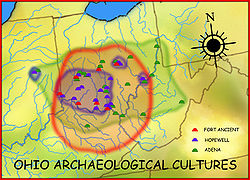
Kentucky Sites West Virginia Sites Indiana Sites Related topics · Ancient Monuments of the Mississippi Valley · burial mound · Eastern Agricultural Complex · Hopewell tradition Hopewellian peoplesWoodland period · List of Hopewell sites · Mound builder (people) · List of archaeological periods (North America)
Hopewellian peoplesWoodland period · List of Hopewell sites · Mound builder (people) · List of archaeological periods (North America)Ohio Hopewell Beam Farm · Benham Mound · Cary Village Site · Cedar-Bank Works · Dunns Pond Mound · Ellis Mounds · Ety Enclosure · Ety Habitation Site · Fort Ancient · Fortified Hill Works · Great Hopewell Road · High Banks Works · Hopeton Earthworks · Hopewell Culture National Historical Park · Indian Mound Cemetery · Keiter Mound · Marietta Earthworks · Moorehead Circle · Mound of Pipes · Nettle Lake Mound Group · Newark Earthworks · Oak Mounds · Perin Village Site · Portsmouth Earthworks · Seip Earthworks and Dill Mounds District · Shawnee Lookout · Tremper Mound and Works · Williamson Mound Archeological District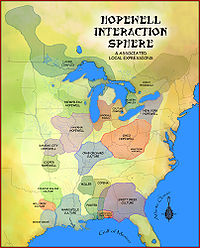
Crab Orchard culture Goodall Focus Goodall Site · Norton Mound GroupHavana Hopewell culture Kansas City Hopewell Marksville culture Miller culture Point Peninsula Complex Swift Creek culture Etowah Indian Mounds · Leake Mounds · Kolomoki Mounds Historic Park · Miner's Creek site, · Nacoochee Mound · Swift Creek mound site · Yearwood siteOther Hopewellian peoples Armstrong culture · Copena culture · Fourche Maline culture · Laurel Complex · Saugeen Complex · Old Stone Fort (Tennessee)Exotic trade items Related topics · Ancient Monuments of the Mississippi Valley · Black drink · burial mound · Calumet (pipe) · Effigy mound · Hopewell pottery · Horned Serpent · Eastern Agricultural Complex · Underwater panther Late Woodland culturesMound builder (people) · List of archaeological periods (North America)
Late Woodland culturesMound builder (people) · List of archaeological periods (North America)Sites Baytown Site · Beattie Park Mound Group · Book Site · Bowen Site (12 MA 61) · Brinsfield I Site · Brokaw Site · Clampitt Site (12-LR-329) · Fisher Site · Hoye Site · Little Maquoketa River Mounds State Preserve · Memorial Park Site · Mott Mounds · Nottingham Site · Ormond Mound · Sommerheim Park · Troyville Earthworks · University of Tennessee Agriculture Farm Mound ·Cultures Alachua culture · Baytown culture · Clemson Island culture · Coles Creek culture · Manahoac · Monongahela culture · Oliver Phase · Plum Bayou culture · Springwells Phase · Troyville culture · Weeden Island culture ·Related topics · Steuben point · Belle Glade culture · Extreme weather events of 535–536 · Fort Ancient culture · Mississippian culture · Oneota · St. Johns culture · Coles Creek and Plum Bayou cultures
Coles Creek and Plum Bayou culturesColes Creek sites Aden Site · Balmoral Mounds · Churupa Plantation Mound · Coles Creek Site · Crippen Point site · Cypress Grove Mound · DePrato Mounds · Greenhouse Site · Filhiol Mound Site · Fisher Site · Flowery Mound · Frogmore Mound Site · Ghost Site Mounds · Greenhouse Site · Insley Mounds · Kings Crossing Site · Lamarque Landing Mound · Marsden Mounds · Mazique Archeological Site · Mott Mounds · Mound Plantation · Peck Mounds · Raffman Site · Scott Place Mounds · Shackleford Church Mounds · Sundown Mounds · Transylvania Mounds · Troyville Earthworks · Venable Mound · Wade Landing Mound ·Coastal Coles Creek sites Atchafalaya Basin Mounds (16SMY10) · Bayou Black Mound (16TR78) · Bayou Cypremont (16SMY7) · Bayou Grande Cheniere Mounds · Bayou L’Ours Site · Bayou Portage Mounds · Bayou Sorrel Mounds (16IV4) · Clovelly Site (16LF64) · Cypress Point Site (16VM112) · Eagle Point Site (16IB123) · Gibson Mounds (16TR5) · Greenwood Cemetery Site (16SMY10) · Kleinpeter Mounds · Little Cheniere Site (16CM22) · Little Pecan Island Site (16CM43) · Jerry Haas Site (16SJ51) · Machias Lake (16SB2) · Morgan Mounds (16VM9) · Pecan Mounds (16SM37) · Pennison Mounds (16AS16) · Portage Mounds (16SM5) · Richeau Field Site (16TR82) · Schwing Place Mound (16IV13) · Southwest of Cut Off Lagoon (16SB50) · St. Gabriel Mounds (16IV128) · Temple Mounds Site (16LF4) ·Plum Bayou sites Chandler Landing Site · Coy Site (3LN20) · Dogtown Site · Hayes Site (35CS196) · Maberry Site · Roland Site (3AR30) · Toltec Mounds ·Related topics · Eastern Agricultural Complex · Fourche Maline culture · Mississippian culture · Natchez · Plaquemine culture · Platform mound · Taensa · Troyville culture · Mississippian and related cultures
Mississippian and related culturesMiddle Mississippian Adams Site · Angel Mounds · Angel Phase · Aztalan State Park · Beasley Mounds Site · Big Eddy Site · Boyd Mounds Site · Brentwood Library Site · Brick Church Mound and Village Site · Cahokia · Castalian Springs · Chucalissa · Cloverdale archaeological site · Dickson Mounds · Dunbar Cave · Fewkes Group Archaeological Site · John Roy Site · Kincaid Mounds · Kuhn Station Site · Marshall Site · Millstone Bluff · Mitchell Site · Monks Mound · Mound Bottom · Murphy Mound Archeological Site · Obion Mounds · Old Town Archaeological Site · Orendorf Site · Prather Site · Rowlandton Mound Site · Sellars Indian Mound · Shiloh Indian Mounds Site · Steed-Kisker culture · Sugarloaf Mound · Swallow Bluff Island Mounds · Tolu Site · Towosahgy · Turk Site · Twin Mounds Site · Wickliffe MoundsSouth Appalachian
MississippianBottle Creek Indian Mounds · Citico · Dauphin Island · Etowah · Fort Walton Culture · Fort Walton Mound · Garden Creek site · Hickory Ridge Cemetery · Hoojah Branch Site · Jere Shine Site · Lake Jackson Mounds · Leon-Jefferson Culture · Letchworth Mounds · Liddell Archeological Site · Moccasin Bend · Moundville · Muscogee (Creek) · Nacoochee Mound · Ocmulgee · Pisgah Phase · Roods Landing · Town Creek Indian Mound · Velda Mound · Waddells Mill Pond SitePlaquemine Mississippian Anna Site · Emerald Mound Site · Fitzhugh Mounds · Flowery Mound · Foster's Mound · Ghost Site Mounds · Grand Village of the Natchez · Holly Bluff Site · Jaketown Site · Julice Mound · Mangum Mound Site · Mazique Archeological Site · Medora Site · Mott Mounds · Pocahontas Mounds · Routh Mounds · Scott Place Mounds · Transylvania Mounds · Venable Mound · Winterville Site ·Caddoan Mississippian Battle Mound Site · Belcher Mound Site · Bluffton Mound · Caddoan Mounds · Gahagan Mounds · Ka-Do-Ha Indian Village · Spiro MoundsUpper Mississippian
culturesAlligator Effigy Mound · Beattie Park Mound Group · Blood Run Site · Clover Site · Dodge Site · Fort Ancient culture · Hartley Fort State Preserve · Leo Petroglyph · Oneota · Roche-a-Cri Petroglyphs · Serpent Mound · SunWatch Indian VillageLate Mississippian /
ProtohistoricAnhaica · Apalachee Province · Belle Meade Phase · Bussell Island · Caddo · Caborn-Welborn culture · Campbell Site · Chiaha · Citico · Coosa chiefdom · Dallas Phase · de Soto Expedition · Eaker Site · Hovey Lake · Joara · Jordan Mounds · Lamar Phase · Mabila · Menard-Hodges Site · Natchez · Nodena Phase · Parkin Site · Slack Farm · Taensa · Tipton Phase · Toqua (Tennessee) · Tunica · Walls PhaseLanguages Religion Ballgame · Black drink · Calumet (pipe) · Chunkey · Earth/fertility cult · Green Corn Ceremony · Horned Serpent · Long-nosed god maskette · Mississippian stone statuary · Platform mound · Shell gorget · Southeastern Ceremonial Complex · Thunderbird · Underwater pantherRelated topics · American Bottom · Chevron bead · Clarksdale bell · Maize · Mississippian culture pottery · Mill Creek chert · Stone box grave Fort Ancient cultureList of archaeological periods (North America) · Mound builder (people)
Fort Ancient cultureList of archaeological periods (North America) · Mound builder (people)Anderson Focus 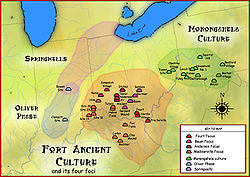
Baum Focus Feurt Focus Buffalo Indian Village Site · Feurt Mounds and Village Site · Hardin Village Site · Leo Petroglyph · Hobson SiteMadisonville Focus Buckner Site · Clay Mound · Cleek-McCabe Site · Clover Site · Fox Farm Site · Hahns Field Site · Larkin Site · Lower Shawneetown · Madisonville Site · Ronald Watson Gravel Site · Sand Ridge Site · Turpin SiteRelated topics · Bone Stone Graves · Bone Mound II · Cole culture · Mississippian culture · Monongahela culture · Oliver Phase · Oneota · Owasco culture · Springwells Phase ·Categories:- Adena culture
- Mound builders (people)
- Pre-Columbian architecture
- Archaic period in the Americas
- Formative period in the Americas
- Archaeological cultures of North America
- Pre-Columbian cultures
- Woodland period of North America
- Native American archeology
- Native American history
- Mounds
Wikimedia Foundation. 2010.

